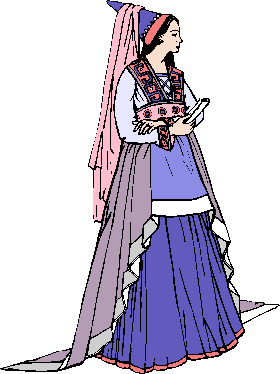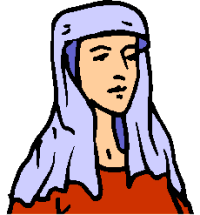Reading
Read the following three chapters in our Textbook, The
Ordination of Women, etc.,
- chapter 8, ‘The Arguments found in Tradition?’, pages
59-67;
- chapter 10, ‘Not allowed to teach?’, pages 77 -
84;
- chapter 13, ‘Not human enough to represent Christ?’,
pages 100-112.
Online
Readings
Exercise 1
- Thomas Aquinas is more logical in his approach than the Fathers
of the Church. Has this logic preserved him from error? Why or why not?
|
The Medieval
Theologians
Theologians in the Middle Ages excluded women from ordination
with arguments that manifest cultural and social prejudice. In this matter they
cannot be relied upon as witness of authentic Tradition.
We will analyse the teachings of three theologians in detail:
Thomas Aquinas gives three reasons why women cannot be ordained
priests.
- The
prohibition for women to teach or to have authority over men.
1 Timothy
2,11-15 and 1
Corinthians 14,34-35 only mean a temporary exclusion of women from speaking
in the assembly, or having another function. Extending Paul's sayings to a
fixing of the status of women goes beyond the inspired sense.
Aquinas will
also have been influenced by the fact that this text had been quoted by the
Didascalia Apostolorum and the Apostolic Constitutions, both of
which were wrongly
attributed to the Apostles themselves.
Conclusion: this
scriptural argument is not a valid reason to exclude women from the priesthood.
If it were, why does
present
Church Law allow women to teach in and preside over liturgical
functions?
- The female sex
cannot signify eminence of degree.
This theological argument is based
on a presumed, threefold inferiority of women.
a. Women are biologically
inferior. Following
Aristotle's view of
procreation, Aquinas believed that a woman is born by some defect in the
generative process.
A woman is a
‘defective male’. The biologically secondary status is also clear
from the belief that the male seed contains the generative power.
The mother only
provides a womb that gives nourishment to the seed/foetus. This view was
common among the
Fathers.
b. Women are socially inferior. A woman is subject to
man by nature, because human reason, though common to both men and women to
some extent, predominates in the
male.
c. Women are created as dependent on men.
Man was
created first. Though both men and women are the image of God as to our
intellectual nature,
man is the
image of God in a special sense.
Aquinas argues that, on account of
these inherent defects, woman cannnot signify eminence of degree and can,
therefore, not represent Christ as an ordained minister.
Conclusion: Since women are absolutely equal to men, both
biologically, socially and in the order of creation, the argument is invalid.
In fact, the argument rests on the social and cultural prejudices of the time.
- ‘Deaconesses’
of the past had no part in the sacrament of Holy Orders
Because of
historical ignorance, Aquinas dismisses the deaconess as ‘a woman who
shares in some act of a deacon, namely who reads the homilies in the
Church’.
We know, however, that deaconesses were validly ordained as
ministers of the
sacramental diaconate.
Conclusion: If Aquinas had known what
we know, he would have admitted the capacity of women for sacramental
ordination.
Thomas was ignorant about important biological facts concerning
men and women. Read
a survey here.
It is clear that Thomas Aquinas’s reasons for rejecting
the ordination of women rested on his ignorance and on the social and cultural
prejudices of the time. Surely his reasonings do not reflect
valid Tradition.
In this matter he is no valid witness to Christ’s revealed
will.
Objection?
The CDF says: ‘The same conviction [that women cannot
be ordained] animates mediaeval theology, even if the Scholastic doctors, in
their desire to clarify by reason the data of faith, often present arguments on
this point that modern thought would have difficulty in admitting or would even
rightly reject.’
Inter Insigniores,
§ 7.
Reply: The truth of the matter is that the enduring
social and cultural prejudices against women form the essence of Aquinas’s
reasoning for excluding women, as reflected in his ‘arguments’
themselves. It is thus obvious that none of his scriptural or theological
reasons are valid. This undermines their authority and shows they cannot
‘witness’ to genuine Christian ‘Tradition’. |
Exercise 2
- How do you rate each of the arguments offered by Bonaventure?
- Do you see parallels (or contrasts) between medieval teaching
on women and medieval art, literature, architecture?
|
According to Bonaventure’s
reasoning, there are four principal reasons why women cannot be ordained:

- Women are inferior to men.
* Women need to have
their heads veiled and so
cannot wear the
tonsure.
* Women
do not bear the
image of God.
* A woman
cannot be the
head of a man.
All this is based on the general prejudices of the
time and a wrong interpretation of
1 Corinthians
11,2-16.
- Women cannnot hold power.
* A woman
‘is not
capable of such power’.
* ‘In Orders there is a concentration
of power which many reasons show to be
not at all
suitable for women’.
This reason too is based on the general
prejudices prevailing at the time, as well as on a wrong interpretation of
1 Timothy
2,11-15.
- Popes have forbidden women to touch sacred objects.
Bonaventure here quotes
an excerpt
from the Decretum Gratiani which obviously is a major argument for him.
However, he does not know that it concerns a forged letter presumably by Pope
Soter which, via the socalled False Decretals, found its way into
the law book
of the Church!
- Deaconesses were not validly ordained to the sacramental
diaconate.
Bonaventure
recognises
the importance of this question, implying that a valid ordination of women
deacons would settle the question of women’s valid admission to Holy
Orders (even if it would leave the question of legitimate ordination open).
However, it is clear from his answer that he did not have accurate
information about women deacons: ‘It is gathered that the women who
communicated with the deacons in reading the homily were called deaconesses.
They received some kind of blessing. Therefore in no way should it be believed
that there were ever women promoted to sacred orders according to the canons [=
laws of the Church].’
If he had known
the ordination
rites and ministry of women deacons, he would certainly have judged
differently.
- Since Christ the Mediator was male, he can only be signified
by the male sex.
Bonaventure does not clearly and in detail explain the
reason why only men can signify Christ in
the paragraph
where he states this argument. However, it is clear from the rest of the
text that women cannot represent Christ in his view because they have an
inferior status and cannnot exercise spiritual power (see no 1 & 2
above!).
Conclusion
If Bonaventure had known what we know, especially if he had
realised how women had functioned as validly ordained deacons in the Church, he
would have admitted the capacity of women for sacramental ordination.
Other
theologians
The same prejudices and mistaken arguments we find with:
None of these theologians is free from errors and from cultural
bias in his judgement. With regard to the ordination of women they may not be
relied upon as reliable witnesses to authentic Tradition. |











